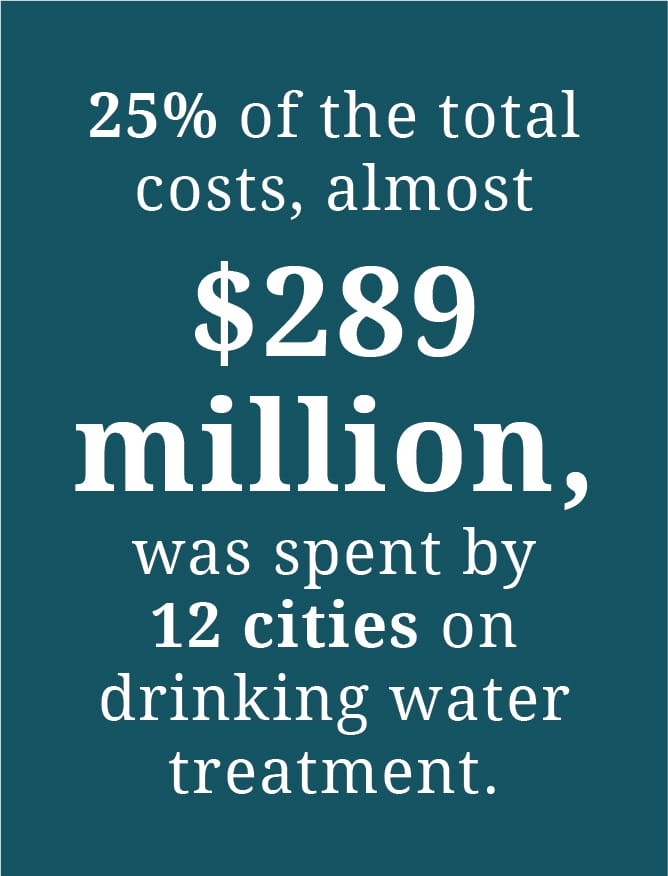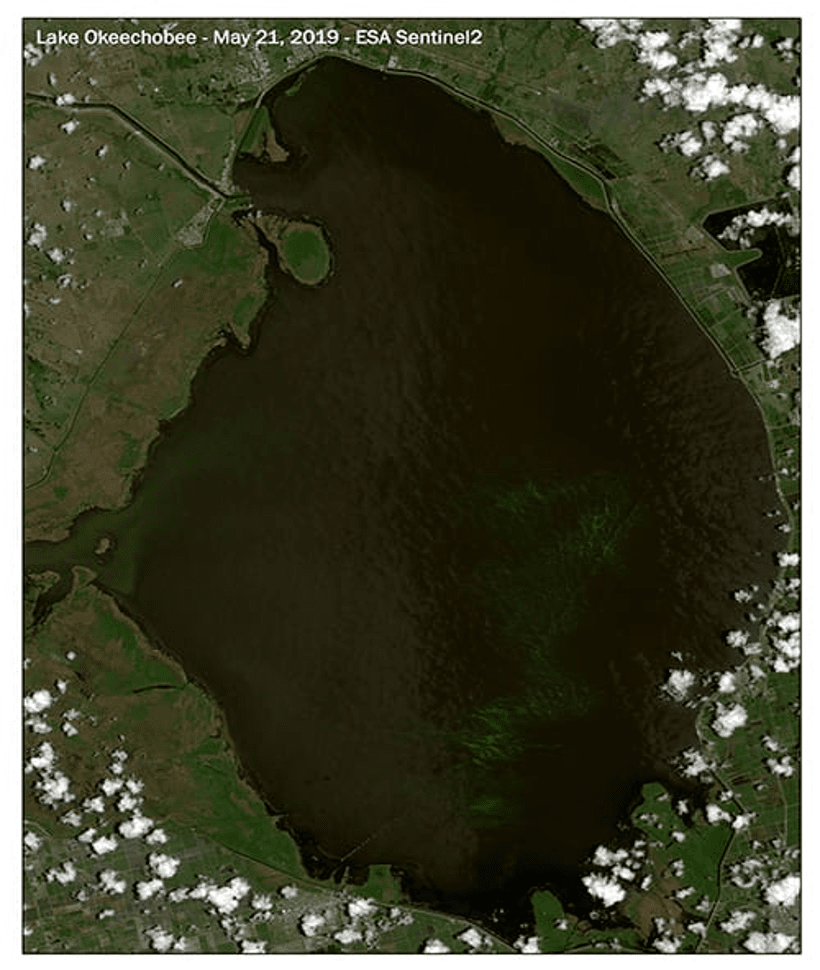
Communities across the United States have spent more than $1 billion since 2010 dealing with outbreaks of potentially toxic algae in lakes, rivers, bays and drinking water supplies, according to an analysis by the Environmental Working Group.
We identified 85 locations, mostly cities and towns, in 22 states that spent money to prevent or treat algae blooms in the past 10 years. The staggering price tag: about $1,158,245,000. This is a first attempt to calculate the cost to communities.
Algae outbreaks can produce toxins that pose serious health hazards to people, pets and aquatic life. Despite a huge surge in reported outbreaks in recent years, the federal government only tracks outbreaks in the largest lakes. Some states do a better job, but they do not always record the cost of dealing with the problem.
To calculate the estimated cost nationwide, EWG searched news databases for reports of algae outbreaks, and what communities have spent to protect or clean up the bodies of water they depend on for household use, recreation and tourism.
Algae Blooms Cost U.S. Communities More Than $1 Billion Since 2010
| State | Total Costs | Locations |
|---|---|---|
| Ohio | $815,184,000 | 11 |
| Oregon | $75,000,000 | 1 |
| Texas | $66,859,627 | 1 |
| California | $52,947,800 | 6 |
| New York | $49,730,000 | 8 |
| Iowa | $40,665,000 | 6 |
| Florida | $19,950,000 | 5 |
| Washington | $16,165,720 | 8 |
| South Carolina | $4,150,000 | 1 |
| New Jersey | $3,326,520 | 8 |
| Minnesota | $3,143,231 | 6 |
| Kansas | $2,943,580 | 4 |
| Wisconsin | $2,570,000 | 3 |
| North Carolina | $1,300,000 | 1 |
| Massachusets | $1,056,012 | 5 |
| Vermont | $1,000,000 | 1 |
| Maine | $745,000 | 3 |
| West Virginia | $700,000 | 1 |
| Missouri | $381,000 | 3 |
| Illinois | $380,000 | 1 |
| Pennsylvania | $37,800 | 1 |
| Michigan | $10,000 | 1 |
| Total | $1,158,245,290 | 85 |
Source: EWG search of news databases, 2010-2020
Communities in Ohio – where a 2014 outbreak in Lake Erie made Toledo’s tap water unsafe to drink – spent more than all other states combined: more than $815 million in documented expenses, or 70 percent of the total cost in all locations. Oregon was second, with $75 million, all in the capital city of Salem, where a 2018 outbreak in a nearby lake also forced a do-not-drink warning.

EWG’s ongoing tracking has found more than 1,000 communities with news reports of algae blooms in 49 states since 2010 – an increase of more than 600 percent in the past decade. The locations are plotted on the interactive map below, with links to reported details.
Our estimate does not include losses to recreation, tourism, commercial fishing, wildlife or other economic fallout from algae outbreaks, which could collectively cost communities billions more every year.
Slimy, Smelly and Dangerous
Blooms of blue-green algae – which are technically not algae, but tiny, one-celled organisms – are triggered by chemical nutrients like nitrogen and phosphorus when they get into bodies of water. Heat and sunlight make the problem worse: As water heats up throughout the summer, algae blooms get bigger and occur more often. In farming areas, runoff from crop fields treated with commercial fertilizer or manure are the main sources of nutrients that feed these blooms. In some urban areas, nitrogen and phosphorus from wastewater and stormwater also contribute to outbreaks.
Algae blooms can spread a smelly blanket of slime across the water. The blooms contain bacteria that can produce dangerous cyanotoxins, which cause nausea, vomiting and longer-term effects, such as liver failure and cancer, when people are exposed through recreational contact or consume the toxins through drinking water. Simple activites we all enjoy in the summer – swimming, boating, sitting on a beach or even walking near a body of water – can make people and animals sick if the water is infected. Every year, dogs die from exposure to toxic algae.
Not all algae outbreaks are toxic, but even trained experts can’t tell the difference without testing. Most of the algae cleanup expenses documented in the news stories EWG tracks are likely related to toxic algae, but it is impossible to know for sure, since the articles do not always identify whether a bloom is toxic.
Treatment and Prevention
As our research shows, treating an algae outbreak once it has infested a lake or contaminated a water supply can be extraordinarily expensive.
Communities whose drinking water comes from a source contaminated by an algae outbreak can install technology to remove bacteria and toxins. Granular activated carbon or powdered activated carbon are the most common. EWG found that 12 cities spent almost $289 million – 25 percent of the total costs we documented – on drinking water treatment. That includes the money communities like Toledo have invested in wholesale improvements to their drinking water systems.
On smaller lakes, many communities treat algae outbreaks in the water instead of focusing on prevention. A common practice is to spray aluminum sulfate, or alum, onto the bloom, which causes the algae and phosphorus to sink to the bottom of the lake, although the phosphorus could be stirred up again by heavy rainfall from a big storm. Out of the 85 locations we examined, 18 used alum to treat an outbreak, at a total cost of about $9.4 million.
What makes more sense than expensive, after-the-fact treatment is prevention – keeping phosphorus and nitrogen from polluting water in the first place. But that’s not always so simple.

Under federal law, farm fields are considered non-point sources of pollution, meaning it’s difficult to pinpoint the exact provenance of farm runoff. As a result, individual farmers are not held accountable for what flows off their fields and into nearby waters.
On the other hand, wastewater treatment plants are considered point sources of pollution, with discharges that can be traced back to their origins. It’s often easier to reduce pollution from point sources, even though agriculture may be the bigger problem in a particular area.
Consider this conundrum in Ohio.
Experts agree that agriculture contributes more nutrients to Lake Erie than cities and towns do, especially given the explosive growth in animal feeding operations in the Maumee River watershed. Yet Toledo and Akron together have spent $637 million on stormwater and wastewater infrastructure improvements since 2014, when Toledo issued a do-not-drink order to more than 400,000 residents for several days because of high levels of cyanotoxins entering the water supply from Lake Erie.
Lake Erie, July 14, 2019

Source: United States Geological Survey Landsat 8
In the past two decades, algae outbreaks in Lake Erie have become an annual occurrence. Despite Toledo’s huge investment since 2014 – $269 million to update stormwater and wastewater infrastructure, and $132.7 million on drinking water treatment – farming practices have proven harder to fix. Above is a satellite image of an algae outbreak in Lake Erie last year.
Case Studies of U.S. Algae Outbreaks
Cayuga Lake, N.Y., September 16, 2018

Source: ESA Sentinel 2
Cayuga Lake, one of New York’s Finger Lakes, is surrounded by agriculture. The state and farmers together have spent $41 million to install 350 different agricultural conservation projects in the lake’s watershed. The goal of these conservation practices was to reduce the flow of nitrogen and phosphorus from farms into the lake.
Grand Lake St. Marys, Ohio, August 23, 2018

Source: ESA Sentinel 2
This lake, near the small city of Celina, has been plagued by algae blooms since well before 2010, the earliest date of EWG’s tracking. The lake and city are surrounded by agriculture, including many animal feeding operations. At least $28.5 million has been spent on the Grand Lake St. Marys blooms since 2010.
Lake Okeechobee, Fla., May 21, 2019

Source: ESA Sentinel 2
Lake Okeechobee also has a bloom every single year, often lasting throughout the summer. In July 2018, 90 percent of the lake was covered by algae. Nitrogen and phosphorus come from many different sources, but septic tanks for homes on the lake and farm fields that surround the lake, especially sugar farms, are thought to be the main sources.
In Florida, at least $6 million has been spent on treating and preventing algae blooms in Lake Okeechobee in recent years. In 2018, $3 million in cleanup and disposal funding was split between seven counties that had declared a state of emergency. In 2020, another $3 million is being spent to remove phosphorus from a canal that feeds into the lake.
But what’s truly astounding is the estimated cost of prevention. In 2017 the Florida legislature passed a plan to build a reservoir and wetlands to filter the lake’s water. But this will cost $2 billion, and many experts say it will fall short of solving the problem.
Total Costs Are Much Larger
EWG’s estimate of more than $1 billion spent in 22 states is almost certainly a significant undercount of treatment and prevention costs nationwide. Online news databases can be missing key articles, or have incomplete information. EWG’s algae outbreak news story map, with more than 1,000 bloom locations since 2010, is also likely a significant undercount of the widespread and growing problem.
Much research on algae blooms is relatively new, so many cities and towns with problems are just starting to investigate treatment and prevention options. Estimates of future costs are just starting to emerge in many locations. For example, recent estimates show that it would cost more than $1 billion to treat the algae outbreak that occurs every year in Vermont’s Lake Champlain.
Our estimate also is limited to prevention and treatment costs. But there are many other costs of algae outbreaks – lower property values, decreased revenue for businesses and commercial fishers. For example, an Ohio study showed that property values near Grand Lake St. Marys fell $51 million due to algae outbreaks between 2009 and 2015, and property values near Buckeye Lake fell by $101 million.
Solutions
It is often difficult and expensive to treat an algae bloom or treat drinking water that contains cyanotoxins. Finding the source of nitrogen and phosphorus that contributes to the outbreaks, and preventing the nutrients from getting into the water in the first place, can be cheaper and more effective.
Where agriculture is the major source of the nutrients algae feed on, farmers should be required to implement conservation practices on farm fields. Simple things like cover crops, grass waterways in field gullies and buffers between fields and bodies of water can go a long way toward preventing algae blooms.
States should also create and enforce more stringent regulations addressing where animal feeding operations can be built, and how many animals they can house. This would reduce the animal manure running off farm fields into lakes and other water bodies in places like Ohio.




